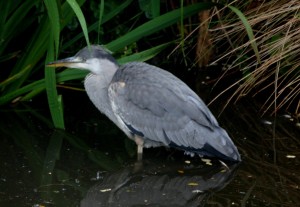 The two herons flapped, as only herons can, low up the narrow burn and their leisurely flight gave the impression they were just wandering. Their slow wing beats were matched by long glides on their huge wings and the birds looked almost eerie in the silence of the snow covered landscape below. No doubt they were heading for a favourite feeding place where they would forage for food ranging from fish to small mammals and frogs to large insects. They are very fond of visiting garden ponds for fish and have been known to take all the fish in a single overnight session. Garden centres sell full scale models of herons aimed at putting such invaders off and in Strathnairn someone bought one for that very purpose. The next morning the owner was not amused to find a real heron trying to mate with the model. Rather that put off a visiting heron it seems as though the model had attracted one.
The two herons flapped, as only herons can, low up the narrow burn and their leisurely flight gave the impression they were just wandering. Their slow wing beats were matched by long glides on their huge wings and the birds looked almost eerie in the silence of the snow covered landscape below. No doubt they were heading for a favourite feeding place where they would forage for food ranging from fish to small mammals and frogs to large insects. They are very fond of visiting garden ponds for fish and have been known to take all the fish in a single overnight session. Garden centres sell full scale models of herons aimed at putting such invaders off and in Strathnairn someone bought one for that very purpose. The next morning the owner was not amused to find a real heron trying to mate with the model. Rather that put off a visiting heron it seems as though the model had attracted one.
The almost majestic flight of the two herons impressed me and I thought that their presence inland was an indication that they had not returned to their heronries yet. The heronries are mainly on the coast such as at the western edge of Inverness and in woodland at Munlochy Bay. In contrast they will hunt inland flowing waters such as rivers and burns and still waters such as lochs and lochans. However, they will return to the coast for two reasons, one being the fact that inland waters are frozen right over and denying them any food. The other reason is that they are ready for the breeding season and they are amongst the earliest of breeding birds. They may well be the earliest of them all and only matched by the golden eagle and raven. Perhaps this is why the heronries are mainly at the coast as even in the worst freezing conditions the ebb and making tides will regularly reveal rich feeding areas in the mud and sand or a rocky coastline.
It is always surprising that such a large bird and, in particular, with such long legs should choose to nest in trees. They do seem to have difficulties in balancing on the branches and twigs. The nest may be added to each year and some of the older ones may be a few feet across. There is often a great deal of squabbling at the beginning of the season as some birds try and steal nest material from other birds’ nests. One of the folk stories about herons is about the huge nests and long legs. In the old days people believed that in each nest there were two holes in the base so that the birds could put their long legs through when incubating eggs! Another folk story, but one that turned out in the end to be perfectly true, was the way in which herons deal with one of their favourite foods – eels. As any fisherman will tell you eels are covered with a slimy substance and need handling with some material so stop this getting on the skin. The heron has special chalky like down that comes from certain feathers and this means the slime of the eel does not affect the plumage in general. Heron numbers peaked in 2001 when, in the UK, there were around 14,000 pairs but since then have dipped back to their mid-1800s levels of roughly 10,000 pairs. In the next few weeks virtually all the herons will have gone back to their coastal heronries and will lay their three or four large bright blue eggs.
Tags: highland wildlife
